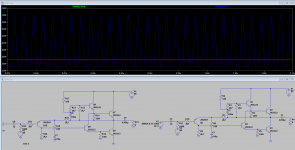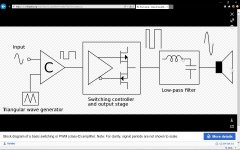Actually, what is "wasted" is not a fact. 'Waste' is an evaluative term used after a judgement based on priorities, preferences, desires, etc. It is a fact that Class A produces a lot of heat, but you have not given us any argument as to why it is "wasted". (That should be the stuff of another thread....)
you might make a sound check between Class A & Class D
Class D is purely analog, nothing to do with digital... It is a common misconception. Read this.
Sorry My Friend I think you are mistaken. As soon a PWM is involved it's no more purely Analogue. PWM Pulse witdh modulator This is DIGITAL it is way go control whatever like, mostly to find in Switchings.
that's it.
The use of PWM isn't the criteria for digital. It's the digitization, which doesn't (necessarily) happen in a class D amp.
Btw, most class A amps do not draw a constant current, especially not push pull ones. This is a good primer on class A, more in line with the OP's question: Class-A Amplifiers explained
Btw, most class A amps do not draw a constant current, especially not push pull ones. This is a good primer on class A, more in line with the OP's question: Class-A Amplifiers explained
My statement is not a personal thought, it is fact. Class A produces alot of wasted heat, 'handy to keep your house warm in winter'.
People will do as they wish, that is all part of the human sychie.
I build both Hi Fi amplifiers and Instrument amplifiers for a living and have done professionally for over 40 years. My experience is wide and varied.
I thank you for your comment.
Well , not exactly , people do as they can , our limits ( physical , intellectual , sensitive , etc.. ) are the boundary of our wish's , if you are an stupid dumb one ( not you ) you can wish what ever you like , dumb result will occurs
i am not saying class D amps are for dumb ones , i am just saying class A amp are for music sensitive lover in real life 😀
.
Last edited:
Check this out..
If you want to find out if this is class A then there is a very EASY WAY
Check Current.
As I wrote:
Connect a AMP METER in series with either VRAIL + or VRAIL -
Don't matter that much, but I use usually PLUS
Connect a 8Ohm Load, never Mind if you have only 7
the rest you know, Input a 1KHZ Sign wave Signal.
If you have an Oscilloscope then hook it up. Parallel to the load.
Power on the AMP and then READ CURRENT.
Now turn up volume control, if CURRENT INCREASE much more than 1 Amp, then it is NOT CLASS A .
Period. If current Stays the same. it is class a. Class A current will not change or not a lot, if volume is increased, and then it will show LESS CURRENT.
Check out this pics..
My Setup as you can see in the pictures is.
Single End Class A - Resistance Based, the bias is made by a 7.5 Ohm 400Watt Resistor.
To start with we have 35.9 Volts VDC+ and 35.9Volts VDC- first picture
We have 4.90 AMPERE IDLE CURRENT. first picture
This makes a Input Power of 35.9 * 4.9 ( taking the short way in calculations) = 175 Watts
We have at the same time 0 volts output, second Picture with a Load of
RE + LOAD = 7.5 * 8 : 7.5+8 = 3.87Ohms Output 0
Then we have full output 14.6 Volts @ 3.87Ohms LOAD + RE =
14.6 Volts * 14.6Volts : 3.87 Ohm = 55.08 WATT RMS Picture 3 - None Clipping
We read at the input Power Picture 4
35.6 Volts VDC+ @ 4.89 Ampere
This States that this AMP is CLASS A - if Current goes up then it's no more CLASS A.
Rest pics are Dummy and RE
Check that out then you know if it is a REAL CLASS A or just a biased A but AB AMP.
hope this clears up the smoke..
Long Live Class A, best sound you can get.
That's exactly what I've done:
If you want to find out if this is class A then there is a very EASY WAY
Check Current.
As I wrote:
Connect a AMP METER in series with either VRAIL + or VRAIL -
Don't matter that much, but I use usually PLUS
Connect a 8Ohm Load, never Mind if you have only 7
the rest you know, Input a 1KHZ Sign wave Signal.
If you have an Oscilloscope then hook it up. Parallel to the load.
Power on the AMP and then READ CURRENT.
Now turn up volume control, if CURRENT INCREASE much more than 1 Amp, then it is NOT CLASS A .
Period. If current Stays the same. it is class a. Class A current will not change or not a lot, if volume is increased, and then it will show LESS CURRENT.
Check out this pics..
My Setup as you can see in the pictures is.
Single End Class A - Resistance Based, the bias is made by a 7.5 Ohm 400Watt Resistor.
To start with we have 35.9 Volts VDC+ and 35.9Volts VDC- first picture
We have 4.90 AMPERE IDLE CURRENT. first picture
This makes a Input Power of 35.9 * 4.9 ( taking the short way in calculations) = 175 Watts
We have at the same time 0 volts output, second Picture with a Load of
RE + LOAD = 7.5 * 8 : 7.5+8 = 3.87Ohms Output 0
Then we have full output 14.6 Volts @ 3.87Ohms LOAD + RE =
14.6 Volts * 14.6Volts : 3.87 Ohm = 55.08 WATT RMS Picture 3 - None Clipping
We read at the input Power Picture 4
35.6 Volts VDC+ @ 4.89 Ampere
This States that this AMP is CLASS A - if Current goes up then it's no more CLASS A.
Rest pics are Dummy and RE
Check that out then you know if it is a REAL CLASS A or just a biased A but AB AMP.
hope this clears up the smoke..
Long Live Class A, best sound you can get.
Attachments
-
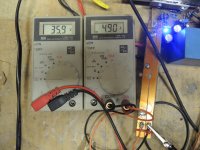 0. input power.jpg209.6 KB · Views: 454
0. input power.jpg209.6 KB · Views: 454 -
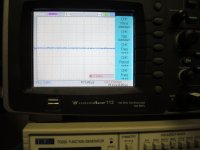 1. No Signal output power.jpg142.2 KB · Views: 457
1. No Signal output power.jpg142.2 KB · Views: 457 -
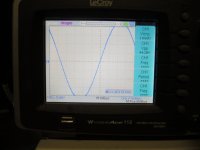 2. Output Power 1KHz RMS 14.6 Volts.jpg92.1 KB · Views: 390
2. Output Power 1KHz RMS 14.6 Volts.jpg92.1 KB · Views: 390 -
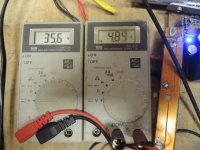 3. Input Power According to Output 14.6Volts.jpg182.7 KB · Views: 383
3. Input Power According to Output 14.6Volts.jpg182.7 KB · Views: 383 -
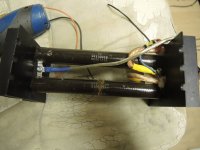 4. Dummy Load 8Ohms.jpg181.4 KB · Views: 383
4. Dummy Load 8Ohms.jpg181.4 KB · Views: 383 -
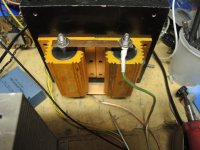 RE 7.5 400.jpg169.5 KB · Views: 136
RE 7.5 400.jpg169.5 KB · Views: 136
Check out my answer beneath.
BTW: Continues means CONSTANT.! nothing more nothing less
Or better ask the masters, don't believe all what you read, And sorry you are wrong again. Go and build one as you think that will be class a and come back and show it, so the guys here can see your work.
I think you need to read that again and then understand what you read, because ROD writes of CONTINUES POWER.
Quote:
A Class-A power amp will typically draw anything from 1/2 to about 1½ times the peak speaker current in its quiescent state (i.e. while it is just sitting there doing nothing).End Quote, do you need more?
2nd Quote:
Class-A Output device(s) conduct through 360 degrees of input cycle (never switch off) - A single output device is possible. The device(s) conduct for the entire waveform in Figure
End 2nd. quote
3rd Quote:
so a typical 8 Watt Class-A amp will draw anything from 700mA to 2 Amps continuous
End Quote 3rd.
With this Rod means whatever you deserve that the amp you can run it at 700mA or up to 2 Amps but continuous, this means it's always the same amount of current. it does not change. Especially the one he means is the DoZ or death of Zen amp.. Take a look at it then you can see the real number, just in case that you still don't believe it. I have build DoZ, and was in contact with ROD.
Hope you understand now.
Thanks for your input.
Regards Chris
As soon you brake the Sine wave with PWM then it is no more ANALOGUE, and I have absolutely no fun to argue with you.,The use of PWM isn't the criteria for digital. It's the digitization, which doesn't (necessarily) happen in a class D amp.
Btw, most class A amps do not draw a constant current, especially not push pull ones. This is a good primer on class A, more in line with the OP's question: Class-A Amplifiers explained
BTW: Continues means CONSTANT.! nothing more nothing less
Or better ask the masters, don't believe all what you read, And sorry you are wrong again. Go and build one as you think that will be class a and come back and show it, so the guys here can see your work.
I think you need to read that again and then understand what you read, because ROD writes of CONTINUES POWER.
Quote:
A Class-A power amp will typically draw anything from 1/2 to about 1½ times the peak speaker current in its quiescent state (i.e. while it is just sitting there doing nothing).End Quote, do you need more?
2nd Quote:
Class-A Output device(s) conduct through 360 degrees of input cycle (never switch off) - A single output device is possible. The device(s) conduct for the entire waveform in Figure
End 2nd. quote
3rd Quote:
so a typical 8 Watt Class-A amp will draw anything from 700mA to 2 Amps continuous
End Quote 3rd.
With this Rod means whatever you deserve that the amp you can run it at 700mA or up to 2 Amps but continuous, this means it's always the same amount of current. it does not change. Especially the one he means is the DoZ or death of Zen amp.. Take a look at it then you can see the real number, just in case that you still don't believe it. I have build DoZ, and was in contact with ROD.
Hope you understand now.
Thanks for your input.
Regards Chris
Last edited:
....My question is if the conclusions in those articles are also true for ...
Two articles, no links?
These are fairly dense essays (for Hi-Fi lit) which discuss many things. What 'conclusions' do you find in them?
I've always found jargon and topology to be very minor contributors. Often less than the color of the capacitors.
The sweet spot:Two articles, no links?
Pass LabsThe Sweet Spot - Pass Labs
Leaving Class A:
Pass LabsLeaving Class A - Pass Labs
Lots of conclusions, did you read them?These are fairly dense essays (for Hi-Fi lit) which discuss many things. What 'conclusions' do you find in them?
For example:
"What we see clearly is that higher bias lowers the distortion at all power levels, and that the distortion is inversely proportional to the bias current."
and
"The benefits of high bias current extend beyond simple harmonic distortion measurements – you also get a reduction of intermodulation distortion (arguably more important), and a lower, more consistent output impedance. As a corollary benefit, the heavy hardware required to support Class A operation will show better thermal stability and will deliver better performance into difficult loads."
The writer of these article is Nelson Pass so I'm not in a position to argue with him, somebody with 50 years of technical experience in audio. I take his words and graphs for facts.I've always found jargon and topology to be very minor contributors. Often less than the color of the capacitors.
If you want to find out if this is class A then there is a very EASY WAY
Check Current.
As I wrote:
Connect a AMP METER in series with either VRAIL + or VRAIL -
I know and with the railfuses in my Threshold SA/1 it was simple but the Krell KRS-100 hasn't any fuses at all.
As said I used a 1 KHz tone cranked up the pot of my preamp till I got 43,3 Volts over the combined 7 Ohm powerresistors. The energymeter and Variac with ampmeter actually showed less AC output at the 43,3 V than at idling.
So no increase at all in amps from the wall.
The KRS-100's (not KSA-100 or KSA-100s that are completely other amps) are complementary amplifiers like the PassLabs XA series (and X series of course) so at lower impedance the Class A "portion" will be inversely lower.
I have read both of them
And I can only say there is nothing to add. it is exactly as Mr. Pass writes it..
The sweet spot:
Pass LabsThe Sweet Spot - Pass Labs
Leaving Class A:
Pass LabsLeaving Class A - Pass Labs
Lots of conclusions, did you read them?
For example:
"What we see clearly is that higher bias lowers the distortion at all power levels, and that the distortion is inversely proportional to the bias current."
and
"The benefits of high bias current extend beyond simple harmonic distortion measurements – you also get a reduction of intermodulation distortion (arguably more important), and a lower, more consistent output impedance. As a corollary benefit, the heavy hardware required to support Class A operation will show better thermal stability and will deliver better performance into difficult loads."
The writer of these article is Nelson Pass so I'm not in a position to argue with him, somebody with 50 years of technical experience in audio. I take his words and graphs for facts.
And I can only say there is nothing to add. it is exactly as Mr. Pass writes it..
You're not arguing with me but with any textbook you'll find on electronics. I'm sorry but you are using a mistaken definition of analog and digital. Where did you get it ? 😕As soon you brake the Sine wave with PWM then it is no more ANALOGUE, and I have absolutely no fun to argue with you.
Please read again Rod Elliot's article. The current draw from a class A amp is only perfectly constant with a single ended, ccs loaded topology (the first Zen amplifier basically). As soon as you introduce a modulated ccs (such as the DOZ) or a push-pull topology, things aren't so constant anymore.BTW: Continues means CONSTANT.! nothing more nothing less
To make it more visual, I attach the simulation of two DOZ, one at iddle (no signal), one with an input signal. The green line is the power drawn from the supply at iddle. The blue line is the power drawn from the supply with a signal present. What conclusion do you make of it ?
Rod Elliot has another article with the basics on the various classes: Power Amp Classes , where you'll find quotes such as "The unfiltered output of a Class-D amp superficially resembles a digital (on-off) signal, but it is purely analogue, and requires high speed analogue design techniques to get a design that works well." 😉
Attachments
You're going to LOVE the upcoming Class-A "Pass DIY Sony VFET" amp from the diyAudio Store. According to Nelson Pass it will be unveiled "real soon now" which I interpret to mean "in the next 45 days". A Class-A output stage which uses a triode-like device as a unity gain follower, needs a quite unusual biasing scheme. And that lead Mr. Pass to select a topology with somewhat unusual bias current vs. signal amplitude behavior. An optimum topology, in my opinion, but only when evaluated from a certain point of view!
Topologies aside, Class A and solid state, do we not mean a special relationship between current and the load (speaker)? Always 'on'? Linearity of the parts? Power in a way that translates to the volume that we listen, against the mechanical load of the moving parts? To power them adequately.... as Rolls-Royce? having 'adequate' power? Its speed/ability/PSU to transfer energy?
The answer was early, as ZM said, bring a light chassis and the motor will shine even more. They're Hot Rods.
The answer was early, as ZM said, bring a light chassis and the motor will shine even more. They're Hot Rods.
In the class-A HPA which I put in the Store, I found that: when the bias is so big that the signal is a negligibly small perturbation, the instrument sings with a very pure tone. IMHO etc
You're not arguing with me but with any textbook you'll find on electronics. I'm sorry but you are using a mistaken definition of analog and digital. Where did you get it ? 😕
Please read again Rod Elliot's article. The current draw from a class A amp is only perfectly constant with a single ended, ccs loaded topology (the first Zen amplifier basically). As soon as you introduce a modulated ccs (such as the DOZ) or a push-pull topology, things aren't so constant anymore.
To make it more visual, I attach the simulation of two DOZ, one at iddle (no signal), one with an input signal. The green line is the power drawn from the supply at iddle. The blue line is the power drawn from the supply with a signal present. What conclusion do you make of it ?
Rod Elliot has another article with the basics on the various classes: Power Amp Classes , where you'll find quotes such as "The unfiltered output of a Class-D amp superficially resembles a digital (on-off) signal, but it is purely analogue, and requires high speed analogue design techniques to get a design that works well." 😉
Yes, nice.
I give you an Example, and this will be the last on this subject.
You get a good bottle of Wine, and you drink just a little bit of it.
But now the bottle is no more full as before.
So you take in whatever means a second WINE and fill up the bottle, to the original amount. That Wine is no MORE PURE.
And this is it, what I mean! BTW I can live with that, because I do not use CLASS D.
What ever you write is OK with me.
Nice simulation there.. so build it, and the show the test here.
So enjoy Sunday.
Regards
Chris
Attachments
Last edited:
I've read the technical articles from the PassLabs website:
- Leaving Class A and the Sweet Spot both written by Nelson Pass on the Class A subject.
My question is if the conclusions in those articles are also true for my Krell KRS-100 an amplifier that consumes approx. 650 Watts when idling, has comparable heatsinking and PSU and Class A ratings comparable with a PassLabs XA-160.5.
I'm not implying I bought a PassLabs quality amplifier, I didn't of course, but I'm just curious if the reasoning in those articles are true for my amps and any amplifier that is a high (fixed) biased amplifier?
Hi, I just read those articles (again) and the answer is in the articles.
Hi Jean Paul,Hi, I just read those articles (again) and the answer is in the articles.
I will read again and hope to find the answer. I'm not a skilled technician but a legal assistant so I know how to analyze text but it is a subject I'm not completely familiar with so if you could just raise a tip of the veil I would be grateful.
Is is simple. He says he builds amplifiers what consume half of the rated power and amplifiers that consume 3 times the rated output power but that is is about best sonical results regardless of class.
Since you are dutch you must have heard from Audio & Techniek (in the eighties) that also described this and choose to design and build small class AB amplifiers that were high in bias or had switches to switch from AB to "A". These designs did not use global feedback!!! This all based on the theories of Matti Otala regarding thermal distortion amongst others like Jean Hiraga, Malcolm Hawksford etc. Almost all the benefits and less the drawbacks of true class A. They were way ahead of their time with a lot of technical issues in audio, I see misunderstandings here on a weekly basis that were already solved then 🙂 Since we are in Europe there is some consensus not to waste energy and secondly energy is expensive here as well. This counts less for some world citizens who can explain you perfectly that they have the "right to pollute".
I was close with Audio & Techniek and followed the design philosophies and still do. When one only plays at 1 Watt or so why have 650 Watts of useless heat?
Audio is literally chockfull of dogma's (A guy named Van der Sluis called it "stokpaardjes") which are very often driven by commercial interests, it not nearly always. Any comment or marketing story should be taken with a pinch off salt but in general consumers don't think like that.
Since you are dutch you must have heard from Audio & Techniek (in the eighties) that also described this and choose to design and build small class AB amplifiers that were high in bias or had switches to switch from AB to "A". These designs did not use global feedback!!! This all based on the theories of Matti Otala regarding thermal distortion amongst others like Jean Hiraga, Malcolm Hawksford etc. Almost all the benefits and less the drawbacks of true class A. They were way ahead of their time with a lot of technical issues in audio, I see misunderstandings here on a weekly basis that were already solved then 🙂 Since we are in Europe there is some consensus not to waste energy and secondly energy is expensive here as well. This counts less for some world citizens who can explain you perfectly that they have the "right to pollute".
I was close with Audio & Techniek and followed the design philosophies and still do. When one only plays at 1 Watt or so why have 650 Watts of useless heat?
Audio is literally chockfull of dogma's (A guy named Van der Sluis called it "stokpaardjes") which are very often driven by commercial interests, it not nearly always. Any comment or marketing story should be taken with a pinch off salt but in general consumers don't think like that.
Last edited:
- Home
- Amplifiers
- Pass Labs
- Class A in itself benificial?
